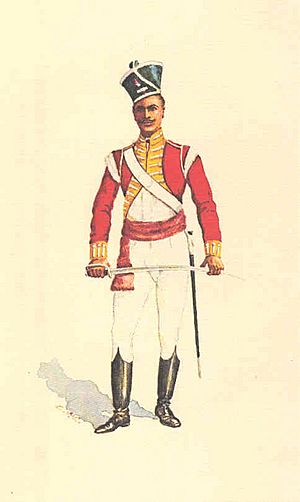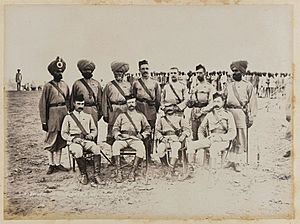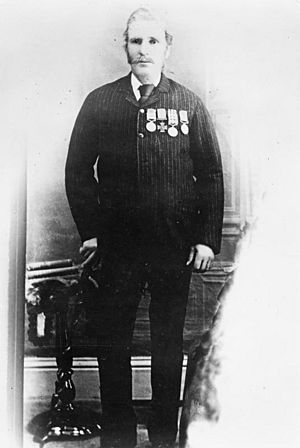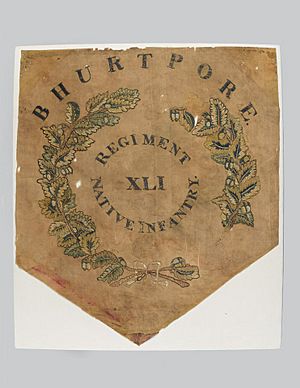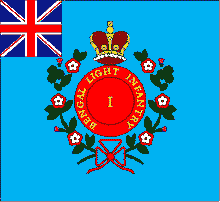Bengal Native Infantry facts for kids
Quick facts for kids Bengal Native Infantry |
|
|---|---|

Flag of the British East India Company
|
|
| Active | 1757–1858 (as part of the East India Company's Bengal Army) 1858–1895 (as part of the Bengal Army of the British Raj) 1895–1903 (under the Bengal command of the British Indian Army) |
| Allegiance | East India Company United Kingdom |
| Branch | Bengal Army |
| Role | Infantry |
| Size | 19 Battalions (1764) 74 Regiments (1857) 45 Regiments (1861) |
| Conflicts | Battle of Plassey Third Carnatic War First Anglo-Mysore War Second Anglo-Mysore War Third Anglo-Mysore War First Anglo-Maratha War Cotiote War Fourth Anglo-Mysore War Second Anglo-Maratha War Invasion of Java Anglo-Nepalese War Third Anglo-Maratha War First Anglo-Burmese War First Opium War First Anglo-Afghan War First Anglo-Sikh War Second Anglo-Sikh War Second Anglo-Burmese War Indian Mutiny Second Opium War Second Anglo-Afghan War Suakin Expedition Third Anglo-Burmese War |
The Bengal Native Infantry was a group of army units that were part of the East India Company's Bengal Army. These units were made up of soldiers recruited from India. They served alongside the Bengal European Infantry, who were soldiers from the United Kingdom.
The first local battalion was formed in 1757. By 1857, there were 74 regiments of Bengal Native Infantry. After the Indian Mutiny in 1857, the British government took direct control of India. The Bengal Native Infantry was then reorganized, and the number of regiments was reduced to 45. The name "Bengal Native Infantry" was no longer used after 1885. These regiments officially stopped existing in 1903 when the different armies in India joined to form the British Indian Army.
Today, some army units in India, Pakistan, and the United Kingdom can trace their history back to the Bengal Native Infantry. For example, the Jat Regiment in the Indian Army and the Royal Gurkha Rifles in the British Army are linked to these older units.
Contents
How Regiments Were Named and Organized
The very first local unit in Bengal was created in 1757. It was called the Galliez Battalion and was known as the Lal Pultan (Red Battalion) by its Indian soldiers.
The Bengal Native Infantry regiments often changed their numbers and names over time. Usually, the "1st Regiment" was the oldest, and higher numbers were for newer units. However, in 1764, the Bengal Native Infantry regiments were renumbered based on how senior their commanding officers were. The regiments were reorganized and renumbered several times, including in 1861, 1864, 1885, and finally in 1903.
The word "Native" in the names of these regiments meant that the soldiers were recruited locally in India or nearby areas. This was different from the "European" infantry, whose soldiers were recruited from the United Kingdom. In 1885, the word "Native" was removed from the names of all military units in the Bengal Army.
Who Joined the Army
The Bengal Army mainly recruited soldiers from higher social groups, like Brahmans, Rajputs, and Bhumihars, especially from areas like Awadh and Bihar.
A typical Bengal Native Infantry regiment had about 800 privates, called sepoys. It also had 120 non-commissioned officers (like havildars and naiks) and 20 Indian officers (like subedars and jemadars). There were also a few British sergeants and 26 British officers.
Each regiment was led by a lieutenant-colonel and was split into 10 companies. Each company had two British officers and two Indian officers. Most of the recruits for the Bengal Native Infantry before the Mutiny came from Bengal, Oudh (Awadh), and nearby regions.
After the Mutiny, regiments that rebelled were officially closed down. In 1861, the twelve Bengal Native Infantry regiments that remained loyal were joined by new units. Some of these new units were quickly formed, while others came from the Punjab.
The Indian Mutiny and Its Effects
During the Indian Mutiny (also known as the First War of Independence), most of the 74 Bengal Native Infantry regiments either rebelled, were disarmed, or peacefully sent home. Those that rebelled fought against their officers or other British forces. Mutiny was a very serious crime for soldiers, and it could lead to severe punishments.
Regiments that mutinied were officially disbanded. Their place in the army's ranking system was then taken by another unit. Some units were disarmed peacefully. This meant their weapons were taken away, often by British soldiers, to prevent them from rebelling. For example, the 33rd and 35th regiments were disarmed at Phillour in 1857. They were surrounded by British troops and artillery and asked to give up their weapons, which they did peacefully.
Soldiers from regiments that were disbanded peacefully usually went back to their homes. Two Bengal Native Infantry regiments were serving in China during the Mutiny, so they were not affected by the events in India.
After the Mutiny, the British government passed the Government of India Act 1858. This law ended the Company rule in India by the East India Company. It gave direct control of India and its armed forces to the British Crown.
The twelve "loyal" regiments that did not mutiny continued to serve. They were allowed to keep their traditions, like wearing red uniforms, and their battle honors. After a big army reform, the Bengal Native Infantry was made smaller and renumbered in 1861. The loyal regiments were given the first numbers, starting with the 21st Regiment becoming the 1st Bengal Native Infantry. After some more changes, the Bengal Native Infantry ended up with 45 regiments.
Battles and Legacy
Battles They Fought In
The Bengal Native Infantry fought in many important wars and battles, including:
- Battle of Plassey
- Third Carnatic War
- First Anglo-Mysore War
- Second Anglo-Mysore War
- Third Anglo-Mysore War
- First Anglo-Maratha War
- Cotiote War
- Fourth Anglo-Mysore War
- Second Anglo-Maratha War
- Invasion of Java
- Anglo-Nepalese War
- Third Anglo-Maratha War
- First Anglo-Burmese War
- First Opium War
- First Anglo-Afghan War
- First Anglo-Sikh War
- Second Anglo-Sikh War
- Second Anglo-Burmese War
- Indian Mutiny
- Second Opium War
- Second Anglo-Afghan War
- Suakin Expedition
- Third Anglo-Burmese War
Their Lasting Impact
In 1903, the Bengal Army became part of the British Indian Army. Many infantry units from the Bengal Native Infantry joined this new force. Even today, several military units in India, Pakistan, and the United Kingdom can trace their history directly back to these old regiments. Many of these modern units still keep the traditions and battle honors of their original regiments.
In India
- The Jat Regiment started in 1795 as the Calcutta Native Militia. After many name changes, it became the 18th regiment of Bengal Native Infantry in 1861. The Jat Regiment also has links to the 43rd and 65th Bengal Native Infantry regiments from before 1857. It still honors the battles its older units fought in.
- The Sikh Regiment is linked to the 14th, 15th, and 45th Bengal Native Infantry regiments that existed after 1861. This regiment also keeps the battle honors and some traditions of its older units.
In Pakistan
- The 6th Battalion of The Punjab Regiment is directly linked to the 20th Bengal Native Infantry regiment from after 1861. However, The Punjab Regiment does not keep any battle honors from before Pakistan became independent.
In the United Kingdom
- The Royal Gurkha Rifles is linked to the 42nd and 43rd Bengal Native Infantry regiments from after 1861. The Royal Gurkha Rifles still keeps the battle honors and traditions of its older units.
See also


